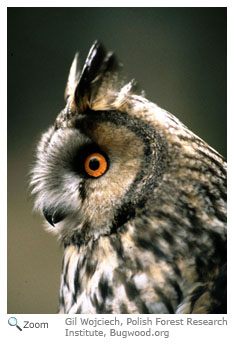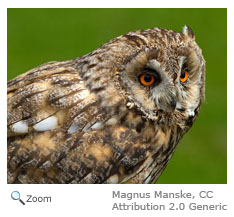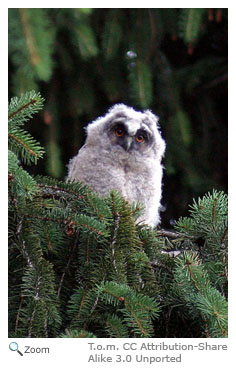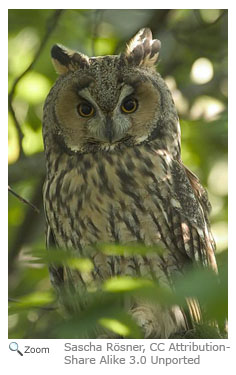Description
 About as big as a crow, the Long-eared Owl is 15 inches long. Its long ear tufts are set very close together and can't be seen when the owl is flying. The Long-eared Owl is brownish-gray with a vertical streaking pattern. It has a chestnut-colored facial disk with small white patches set under bright yellow eyes. About as big as a crow, the Long-eared Owl is 15 inches long. Its long ear tufts are set very close together and can't be seen when the owl is flying. The Long-eared Owl is brownish-gray with a vertical streaking pattern. It has a chestnut-colored facial disk with small white patches set under bright yellow eyes.
Range
The Long-eared Owl has a large range. It stretches from Eastern Canada to the Northeast and from central Canada south through California, Texas and northern Florida. The Long-eared Owl spends winters in the southern part of its breeding range. It also lives in Europe, Asia and northern and eastern Africa.
Habitat
 The Long-eared Owl lives in dense coniferous and deciduous forests up to 2000 meters in elevation. It lives along water, including streams and desert oases. The Long-eared Owl also lives near grasslands, wetlands, marshes and farmland. The Long-eared Owl lives in dense coniferous and deciduous forests up to 2000 meters in elevation. It lives along water, including streams and desert oases. The Long-eared Owl also lives near grasslands, wetlands, marshes and farmland.
|
|
Diet
 With their excellent eyesight and hearing, the Long-eared Owl hunts almost exclusively at night. It hunts mostly from the ground or from low areas in trees. The Long-eared Owl preys on small mammals like voles, deer mice, kangaroo rats and pocket gophers. It is also known to eat small snakes, birds and insects. To kill its prey, the Long-eared Owl bites the back of the skull and swallows the animal whole. With their excellent eyesight and hearing, the Long-eared Owl hunts almost exclusively at night. It hunts mostly from the ground or from low areas in trees. The Long-eared Owl preys on small mammals like voles, deer mice, kangaroo rats and pocket gophers. It is also known to eat small snakes, birds and insects. To kill its prey, the Long-eared Owl bites the back of the skull and swallows the animal whole.
Life Cycle
 Breeding between February and July, the Long-eared Owl raises 5 or 6 eggs per season. The eggs are white, smooth and glossy. The female incubates her eggs for 25 to 30 days, taking short breaks to fly at night. After hatching, chicks leave the nest at 21 days. At this point, the chicks are unable to fly, but instead spend time in nearby brush. When they are 35 days old, the chicks learn to fly. They leave their parents after 10 or 11 weeks. Breeding between February and July, the Long-eared Owl raises 5 or 6 eggs per season. The eggs are white, smooth and glossy. The female incubates her eggs for 25 to 30 days, taking short breaks to fly at night. After hatching, chicks leave the nest at 21 days. At this point, the chicks are unable to fly, but instead spend time in nearby brush. When they are 35 days old, the chicks learn to fly. They leave their parents after 10 or 11 weeks.
Behavior
 The Long-eared Owl is very quiet during the day and difficult to detect. They are experts at camouflage, and are able to elongate their slender bodies and compress their feathers to resemble the trunk of a tree. The Long-eared Owl is very quiet during the day and difficult to detect. They are experts at camouflage, and are able to elongate their slender bodies and compress their feathers to resemble the trunk of a tree. |





